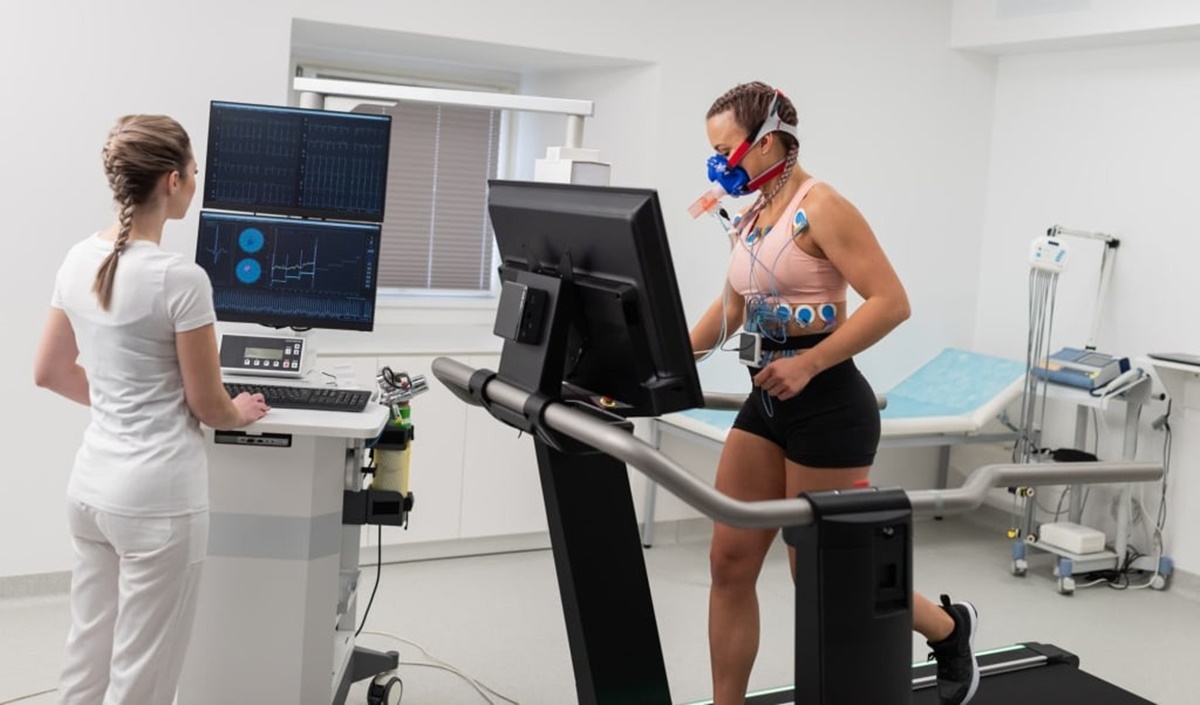

Featured
Why Is Health Education Important?
Modified: January 2, 2024
Discover why health education is crucial for leading a healthy lifestyle. Explore the featured benefits and importance of health education in promoting overall well-being.
Introduction
Health education plays a crucial role in improving individuals’ knowledge, skills, attitudes, and behaviors related to their health and well-being. It encompasses a wide range of topics, including nutrition, physical activity, disease prevention, sexual and reproductive health, mental health, and substance abuse. By providing individuals with accurate and up-to-date information, health education empowers them to make informed decisions and take control of their own health.
In today’s fast-paced and hectic world, where lifestyle-related diseases are on the rise, health education has become more important than ever. It equips individuals with the knowledge and skills necessary to prevent diseases, promote healthy lifestyles, and address mental health issues. Moreover, it helps reduce health disparities by ensuring access to information and resources for all segments of society, regardless of age, gender, ethnicity, or socioeconomic status.
In this article, we will explore the significance of health education and its numerous benefits. We will delve into how health education can prevent diseases, promote healthy behaviors, enhance decision-making skills, address mental health issues, and reduce health disparities. Additionally, we will highlight the role of health education in schools, communities, workplaces, and specific populations. By the end of this article, you will have a deeper understanding of why health education is vital for individuals and society as a whole.
The Importance of Health Education
Health education is of utmost importance in today’s world, where unhealthy lifestyles and preventable diseases are on the rise. It serves as a powerful tool in empowering individuals to take charge of their own health and make informed decisions. Here are some key reasons why health education is crucial:
1. Disease Prevention: Health education equips individuals with the knowledge and skills to prevent diseases. By providing information about healthy behaviors, such as maintaining a balanced diet, being physically active, practicing safe sex, and avoiding substance abuse, health education helps individuals reduce their risk of developing chronic illnesses like heart disease, diabetes, and certain types of cancer.
2. Promotion of Healthy Lifestyles: Health education promotes healthy lifestyles by encouraging individuals to adopt positive behaviors. It helps them understand the benefits of regular exercise, proper nutrition, and adequate sleep. By raising awareness about the importance of self-care, stress management, and mental well-being, health education empowers individuals to make healthier choices in their day-to-day lives.
3. Enhanced Decision-Making Skills: Health education equips individuals with the necessary information and critical thinking skills to make informed decisions about their health. It helps them evaluate the risks and benefits of different lifestyle choices, medical treatments, and preventive measures. By fostering decision-making skills, health education empowers individuals to make choices that align with their health goals and values.
4. Building Self-Esteem and Confidence: Health education also plays a crucial role in building self-esteem and confidence. By providing information about body image, self-acceptance, and positive self-care practices, it helps individuals develop a healthy sense of self-worth. This, in turn, promotes mental well-being and cultivates a positive attitude towards personal health and self-care.
5. Addressing Mental Health Issues: Health education is not limited to physical health alone. It also addresses mental health issues and promotes mental well-being. By providing information about mental illnesses, stress management techniques, and available resources, health education helps reduce the stigma associated with mental health and encourages individuals to seek help when needed.
6. Reducing Health Disparities: Health education plays a crucial role in reducing health disparities by ensuring equal access to information and resources for all individuals. By addressing the specific needs and challenges faced by different populations, such as minority groups, low-income communities, and individuals with disabilities, health education helps bridge the gap and promote health equity.
Overall, health education is an essential component of public health strategies. It empowers individuals to make informed decisions, adopt healthy behaviors, and take control of their own health outcomes. By promoting disease prevention, healthy lifestyles, enhanced decision-making skills, self-esteem and confidence, and addressing mental health issues, health education contributes to the overall well-being of individuals and society as a whole.
Benefits of Health Education
Health education not only provides individuals with valuable knowledge about health-related topics but also offers numerous benefits that can positively impact their overall well-being. Here are some key benefits of health education:
1. Improved Health Literacy: Health education enhances individuals’ understanding of health-related information and concepts, enabling them to make informed decisions regarding their health. It equips individuals with the necessary knowledge and skills to navigate the healthcare system, understand medical terminology, and interpret health-related information accurately.
2. Disease Prevention: One of the primary benefits of health education is its role in preventing diseases. By educating individuals about the importance of preventive measures such as vaccinations, regular screenings, and healthy lifestyle choices, health education helps reduce the incidence of preventable illnesses and promotes overall population health.
3. Behavior Change: Health education is instrumental in promoting positive behavior change. By providing individuals with information about the consequences of unhealthy behaviors, such as smoking, poor nutrition, and sedentary lifestyle, health education motivates individuals to adopt healthier habits. It helps individuals understand the immediate and long-term benefits of making positive choices for their well-being.
4. Improved Self-Management: Health education empowers individuals to take an active role in managing their own health and well-being. By providing individuals with strategies for self-care, disease management, and medication adherence, health education promotes self-efficacy and allows individuals to effectively manage their health conditions.
5. Enhanced Quality of Life: Health education contributes to an improved quality of life by promoting healthy habits and behaviors. By educating individuals about the importance of nutrition, physical activity, stress management, and self-care, health education helps individuals make choices that enhance their overall well-being and lead to a higher quality of life.
6. Increased Empowerment: Health education empowers individuals by providing them with the necessary knowledge and skills to make informed choices about their health. This empowerment leads to increased self-confidence and a sense of control over one’s own well-being.
7. Cost Savings: Health education can result in significant cost savings for individuals, families, and healthcare systems. By preventing diseases and promoting healthy habits, health education reduces the need for expensive medical treatments, hospitalizations, and long-term care.
8. Positive Impact on Communities: Health education not only benefits individuals but also has a positive impact on communities as a whole. By promoting healthier habits and behaviors, health education contributes to the overall well-being and productivity of communities, leading to increased social and economic development.
Overall, health education offers a wide range of benefits, from improved health literacy and disease prevention to behavior change and increased empowerment. By equipping individuals with the necessary knowledge and skills, health education has the potential to transform lives and create healthier communities.
Preventing Diseases through Health Education
Health education plays a critical role in preventing diseases by providing individuals with the knowledge and tools necessary to make informed decisions about their health. Here are some ways in which health education contributes to disease prevention:
1. Promoting Vaccinations: Health education raises awareness about the importance of vaccinations in preventing the spread of infectious diseases. By providing individuals with accurate information about vaccine safety, efficacy, and benefits, health education helps increase vaccination rates and prevent the resurgence of vaccine-preventable diseases.
2. Encouraging Healthy Lifestyle Choices: Health education promotes healthy lifestyle choices, such as regular exercise, balanced nutrition, and adequate sleep, which are essential for disease prevention. By educating individuals about the risks associated with unhealthy behaviors, such as tobacco and alcohol use, poor diet, and sedentary lifestyle, health education motivates individuals to adopt healthier habits, thus reducing the risk of developing chronic diseases.
3. Providing Information on Disease Risk Factors: Health education provides individuals with information about the risk factors associated with various diseases, such as heart disease, diabetes, and cancer. By understanding these risk factors, individuals can take preventive measures, such as engaging in regular screening tests, managing chronic conditions, and making lifestyle changes to reduce their risk of developing these diseases.
4. Educating about Early Detection: Health education emphasizes the importance of early detection of diseases through regular screenings and self-examinations. By educating individuals about the signs and symptoms of various diseases, as well as the appropriate screening methods, health education empowers individuals to seek timely medical attention, leading to early diagnosis and more effective treatment.
5. Raising Awareness about Communicable Diseases: Health education plays a crucial role in raising awareness about communicable diseases, such as sexually transmitted infections and HIV/AIDS. By providing individuals with information about modes of transmission, prevention strategies, and available resources, health education helps reduce the spread of these diseases and promote safer sexual practices.
6. Empowering Individuals to Manage Chronic Conditions: Health education equips individuals with the knowledge and skills to effectively manage chronic conditions, such as diabetes, hypertension, and asthma. By educating individuals about medication adherence, lifestyle modifications, and self-care practices, health education helps individuals reduce the impact of chronic diseases on their overall health and well-being.
Overall, health education serves as a powerful tool in preventing diseases by promoting healthy lifestyle choices, providing information on disease risk factors, educating about early detection, raising awareness about communicable diseases, and empowering individuals to manage chronic conditions. By equipping individuals with the necessary knowledge and skills, health education empowers them to make informed decisions about their health and take proactive measures to prevent diseases.
Promoting Healthy Lifestyles
Health education plays a crucial role in promoting healthy lifestyles by providing individuals with the knowledge, skills, and motivation to make informed choices that enhance their overall well-being. Here are some ways in which health education promotes healthy lifestyles:
1. Nutrition Education: Health education provides individuals with information about proper nutrition and the importance of a balanced diet. It educates individuals about the nutritional value of different foods, portion control, and the benefits of incorporating fruits, vegetables, whole grains, and lean proteins into their diet. By promoting healthy eating habits, health education helps individuals maintain a healthy weight, reduce the risk of chronic diseases, and improve overall nutrition.
2. Physical Activity Promotion: Health education emphasizes the importance of regular physical activity for maintaining good health. It educates individuals about the benefits of exercise, the guidelines for physical activity, and different types of exercises suitable for various fitness levels. By promoting physical activity, health education helps individuals improve cardiovascular health, strengthen muscles and bones, manage weight, and reduce the risk of chronic diseases.
3. Stress Management Techniques: Health education provides individuals with strategies for managing stress and promoting mental well-being. It educates individuals about the impact of chronic stress on physical and mental health and offers techniques such as deep breathing, mindfulness, meditation, and time management to cope with stress effectively. By promoting stress management, health education helps individuals maintain a healthy work-life balance, reduce the risk of stress-related illnesses, and improve overall well-being.
4. Sleep Education: Health education emphasizes the importance of adequate sleep for overall health and well-being. It educates individuals about the benefits of quality sleep and provides strategies for improving sleep hygiene. By promoting healthy sleep habits, health education helps individuals enhance cognitive function, maintain a healthy immune system, regulate mood, and prevent sleep-related disorders.
5. Substance Abuse Prevention: Health education educates individuals about the risks and consequences of substance abuse. It raises awareness about the impact of drugs, alcohol, and tobacco on physical and mental health and provides information about available resources for addiction treatment and support. By promoting substance abuse prevention, health education helps individuals make informed decisions, resist peer pressure, and maintain a substance-free lifestyle.
6. Health Literacy: Health education enhances individuals’ health literacy, enabling them to access, understand, and utilize health information effectively. It equips individuals with the skills to critically evaluate health-related information, navigate healthcare systems, and make informed decisions about their own health. By promoting health literacy, health education empowers individuals to take an active role in managing their health and making choices that align with their well-being.
Overall, health education plays a vital role in promoting healthy lifestyles by providing individuals with information, skills, and resources to make informed choices about nutrition, physical activity, stress management, sleep, and substance abuse prevention. By empowering individuals to adopt healthy habits, health education contributes to overall well-being and helps individuals lead healthier and more fulfilling lives.
Enhancing Decision-Making Skills
Health education plays a significant role in enhancing individuals’ decision-making skills when it comes to their health and well-being. By providing individuals with relevant information, critical thinking skills, and tools for analysis, health education empowers individuals to make informed decisions that align with their health goals. Here are some ways in which health education enhances decision-making skills:
1. Providing Accurate Information: Health education equips individuals with accurate and up-to-date information about various health-related topics. This information enables individuals to make informed decisions based on scientific evidence rather than myths or misconceptions. By providing reliable information about preventive measures, treatment options, and lifestyle choices, health education empowers individuals to make well-informed decisions about their health.
2. Understanding Risks and Benefits: Health education helps individuals develop an understanding of the risks and benefits associated with different health-related decisions. Whether it’s choosing between different treatment options, evaluating the pros and cons of certain behaviors, or making decisions about preventive measures, health education provides individuals with the tools to assess the potential risks and benefits and make decisions that align with their health priorities.
3. Evaluating Health Information: In today’s digital age, where health information is readily available online, health education plays a crucial role in teaching individuals how to evaluate the credibility and reliability of health information. By teaching critical thinking skills, fact-checking techniques, and source evaluation, health education enables individuals to discern between trustworthy and misleading information. This empowers individuals to make decisions based on evidence-based information.
4. Assessing Personal Values and Priorities: Health education encourages individuals to assess their personal values and priorities when making health-related decisions. It promotes self-reflection and self-awareness, helping individuals understand their own beliefs, goals, and preferences. By aligning decisions with personal values and priorities, health education enables individuals to make choices that resonate with their unique circumstances and aspirations.
5. Considering Long-term Consequences: Health education emphasizes the significance of considering long-term consequences when making health-related decisions. It encourages individuals to think beyond immediate gratification and consider the potential impact of their choices on their future health and well-being. This promotes a proactive approach to decision-making that prioritizes long-term benefits and sustainability.
6. Encouraging Shared Decision-Making: Health education recognizes the importance of shared decision-making between individuals and healthcare professionals. It promotes effective communication and collaboration between individuals and healthcare providers, facilitating discussions about treatment options, potential risks, and individual preferences. This collaborative decision-making process ensures that individuals are actively involved in their own healthcare and have the necessary information to make decisions that align with their values and goals.
Overall, health education enhances individuals’ decision-making skills by providing accurate information, fostering critical thinking, promoting self-awareness, considering long-term consequences, and encouraging shared decision-making. By empowering individuals with the knowledge and tools to make informed decisions about their health, health education enables individuals to take control of their own well-being and make choices that lead to optimal health outcomes.
Building Self-Esteem and Confidence
Health education plays a pivotal role in building self-esteem and confidence by promoting positive self-perception and equipping individuals with the knowledge and skills to take care of their own health. Through education and awareness, health education empowers individuals to make informed decisions and take control of their well-being. Here are some ways in which health education builds self-esteem and confidence:
1. Body Image and Acceptance: Health education addresses the importance of body image and self-acceptance. It promotes a positive body image by encouraging individuals to embrace their unique physique and appreciate their bodies for their functionality rather than external appearance. By providing information about healthy body image, media literacy, and self-acceptance, health education helps individuals develop a more positive attitude towards their bodies and boost their self-esteem.
2. Promoting Self-Care Practices: Health education emphasizes the significance of self-care practices for overall well-being. It educates individuals about the importance of taking care of their physical, emotional, and mental health. By providing information about self-care techniques, stress management, and healthy coping strategies, health education empowers individuals to prioritize their own well-being. This promotes a sense of self-worth and confidence in their ability to take charge of their own health.
3. Encouraging Positive Health Behaviors: Health education encourages individuals to adopt positive health behaviors, such as regular physical activity, proper nutrition, and stress management. By highlighting the benefits of these behaviors and providing strategies for implementation, health education instills a sense of accomplishment and self-confidence in individuals as they take steps towards improving their health and well-being.
4. Providing Skills for Disease Prevention: Health education equips individuals with the knowledge and skills to prevent diseases and manage their own health. By educating individuals about disease prevention strategies, health screenings, and early intervention measures, health education empowers individuals to take proactive steps towards maintaining their health. This sense of empowerment increases self-esteem and confidence in individuals’ ability to protect and care for their own well-being.
5. Fostering Empowerment through Health Decision-Making: Health education fosters empowerment by emphasizing the importance of individual decision-making when it comes to health choices. It encourages individuals to be active participants in their own health and well-being by providing information, teaching decision-making skills, and promoting autonomy. By allowing individuals to make choices based on their own values and needs, health education helps build self-esteem and confidence in decision-making abilities.
6. Facilitating Peer Support and Engagement: Health education often takes place in group settings, which creates opportunities for peer support and engagement. By participating in group activities and discussions, individuals can gain support and perspective from their peers, building self-esteem and confidence as they realize they are not alone in their health journey.
Overall, health education plays a vital role in building self-esteem and confidence by promoting positive body image and self-acceptance, encouraging self-care practices, fostering positive health behaviors, providing disease prevention skills, fostering empowerment in health decision-making, and facilitating peer support and engagement. By equipping individuals with the knowledge and skills to care for their own health, health education empowers them to develop a positive self-perception and take proactive steps towards achieving optimal well-being.
Addressing Mental Health Issues
Health education plays a vital role in addressing mental health issues by increasing awareness, reducing stigma, and providing individuals with the necessary information and resources to seek help and support. Here are some key ways in which health education addresses mental health issues:
1. Raising Awareness: Health education raises awareness about mental health issues by providing individuals with accurate information about common mental illnesses, their symptoms, and available treatment options. By increasing understanding and dispelling myths about mental health, health education helps reduce stigma and promotes a more compassionate and supportive society.
2. Promoting Early Intervention: Health education emphasizes the importance of early intervention in addressing mental health issues. By providing individuals with knowledge about the warning signs of mental illnesses, health education enables early identification and prompts individuals to seek timely help. This can lead to better outcomes, as early intervention is crucial for effective treatment and management of mental health conditions.
3. Providing Coping Strategies: Health education equips individuals with coping strategies for managing stress, anxiety, and other mental health challenges. By promoting self-care practices, stress management techniques, and healthy coping mechanisms, health education empowers individuals to develop resilience and effectively navigate the ups and downs of life.
4. Offering Resources and Support: Health education connects individuals to available resources and support systems for mental health. It provides information about counseling services, helplines, support groups, and online communities. By ensuring individuals know where to turn for help, health education bridges the gap between individuals in need and the support systems that can assist them.
5. Encouraging Self-Care and Self-Advocacy: Health education promotes self-care and self-advocacy in the realm of mental health. It educates individuals about the importance of taking care of their mental well-being and encourages them to prioritize their own mental health needs. By empowering individuals to seek help, engage in self-care practices, and advocate for their own mental well-being, health education promotes a proactive approach to mental health management.
6. Fostering a Supportive Environment: Health education fosters a supportive environment for individuals with mental health issues. By educating communities, workplaces, and schools about mental health, health education helps create a culture of understanding, empathy, and support. This can contribute to reduced stigma and increased acceptance for individuals struggling with mental health challenges.
Overall, health education plays a crucial role in addressing mental health issues by raising awareness, promoting early intervention, providing coping strategies, offering resources and support, encouraging self-care and self-advocacy, and fostering a supportive environment. By equipping individuals with knowledge and empowering them to seek help and support, health education contributes to the well-being of individuals and helps build a more mentally healthy society.
Reducing Health Disparities
Health education plays a crucial role in reducing health disparities by ensuring equal access to information, resources, and opportunities for individuals from diverse backgrounds. It aims to address the unequal distribution of health outcomes among different populations and promote health equity. Here are some ways in which health education contributes to reducing health disparities:
1. Increasing Access to Information: Health education ensures that individuals from all backgrounds have access to accurate and culturally appropriate health information. By providing information in different languages, using diverse communication channels, and addressing the specific needs of different populations, health education helps bridge the information gap and ensures that everyone has equal access to vital health knowledge.
2. Tailoring Health Messages: Health education recognizes the importance of tailoring health messages to diverse populations. It takes into account cultural, linguistic, and socioeconomic factors to ensure that health information is relevant and relatable to individuals from different backgrounds. By tailoring messages, health education promotes inclusivity and facilitates better understanding and engagement among diverse communities.
3. Addressing Social Determinants of Health: Health education acknowledges that social determinants of health, such as socioeconomic status, education, and access to healthcare, play a significant role in health disparities. It aims to address these underlying factors by providing individuals with tools and resources to overcome barriers related to social determinants of health. By equipping individuals with knowledge on how to navigate the healthcare system, access affordable healthcare, and advocate for their needs, health education empowers them to overcome socioeconomic barriers that contribute to health disparities.
4. Fostering Health Literacy: Health education promotes health literacy among individuals from all backgrounds. It equips individuals with the skills to understand and utilize health information effectively, empowering them to make informed decisions about their health. By fostering health literacy, health education enables individuals to navigate complex healthcare systems, understand medical terminology, and advocate for their own health needs.
5. Addressing Cultural and Linguistic Barriers: Health education recognizes that cultural and linguistic factors can create barriers to accessing healthcare and understanding health information. It works towards incorporating cultural sensitivity and linguistic diversity into health education programs. By providing information in different languages, engaging with community members, and considering cultural norms and beliefs, health education helps overcome these barriers and ensures that individuals from diverse backgrounds can access and understand health information.
6. Collaboration and Partnerships: Health education works collaboratively with community organizations, healthcare providers, and public health agencies to reduce health disparities. By building partnerships and sharing resources, health education initiatives can reach underserved communities and bridge the gap in access to health information and services. Collaboration fosters a collective effort to address health disparities and promote health equity.
Overall, health education plays a vital role in reducing health disparities by increasing access to information, tailoring health messages, addressing social determinants of health, fostering health literacy, addressing cultural and linguistic barriers, and promoting collaboration and partnerships. By ensuring that individuals from diverse backgrounds have equal opportunities to access and understand health information, health education works towards leveling the playing field and promoting health equity for all.
Creating Awareness about Health Risks and Safety Measures
Health education plays a critical role in creating awareness about health risks and safety measures. By providing individuals with accurate and up-to-date information, health education empowers them to make informed decisions and take necessary precautions to protect their health. Here are some ways in which health education creates awareness about health risks and safety measures:
1. Communicating Potential Health Risks: Health education raises awareness about various health risks, including those associated with specific diseases, environmental factors, and lifestyle choices. It provides individuals with information about the causes, symptoms, and potential consequences of these risks, enabling them to take proactive measures to reduce their exposure or modify their behaviors accordingly.
2. Sharing Information on Preventive Measures: Health education equips individuals with knowledge on preventive measures to reduce the risk of health conditions. It educates individuals about practices such as vaccination, regular check-ups, screenings, and maintaining proper hygiene. By communicating the importance of these measures, health education empowers individuals to prioritize prevention and take necessary steps to safeguard their health.
3. Promoting Safety Practices: Health education promotes safety practices to minimize the risk of accidents and injuries. It raises awareness about safety measures in various contexts, such as at home, in the workplace, during physical activity, or while driving. By providing information about safety guidelines, equipment, and precautions, health education helps individuals make responsible choices to protect themselves and others.
4. Addressing Environmental Health Hazards: Health education educates individuals about environmental health hazards, such as air pollution, water contamination, or exposure to harmful substances. It provides information about the potential health effects of these hazards and offers strategies to minimize exposure. By raising awareness about environmental health risks, health education encourages individuals to create healthier environments and advocate for necessary changes to protect public health.
5. Encouraging Emergency Preparedness: Health education emphasizes the importance of emergency preparedness to address potential health risks and disasters. It provides individuals with information on how to respond during emergencies, create emergency plans, and assemble emergency kits. By promoting preparedness, health education empowers individuals to take proactive steps to protect their health and safety in crisis situations.
6. Promoting Health and Safety at Work: Health education focuses on promoting health and safety in the workplace. It educates employees about occupational hazards, ergonomics, proper use of equipment, and the importance of taking breaks. By creating awareness about work-related health risks and safety measures, health education contributes to creating a safe and healthy work environment.
7. Adapting to Changing Health Risks: Health education stays up-to-date with emerging health risks and evolving safety measures to address new challenges. It ensures that individuals are informed about the latest developments and strategies to protect their health. By adapting to changing health risks, health education plays a proactive role in keeping individuals informed and prepared.
Overall, health education creates awareness about health risks and safety measures by communicating potential risks, sharing information on preventive measures, promoting safety practices, addressing environmental health hazards, encouraging emergency preparedness, promoting health and safety at work, and staying up-to-date with evolving health risks. By providing individuals with the necessary knowledge and tools, health education empowers them to make informed decisions and take necessary precautions to maintain their health and safety.
Empowering Individuals to Take Charge of their Health
Health education plays a vital role in empowering individuals to take charge of their own health. By providing individuals with knowledge, skills, and resources, health education enables them to make informed decisions, adopt healthy behaviors, and actively participate in their own well-being. Here are some ways in which health education empowers individuals to take charge of their health:
1. Access to Information: Health education equips individuals with accurate and up-to-date information about various health topics. It provides individuals with knowledge about disease prevention, healthy lifestyles, and available resources. By having access to reliable information, individuals can make informed decisions about their health and take proactive steps to maintain well-being.
2. Developing Health Literacy: Health education promotes health literacy, which refers to individuals’ ability to understand and use health information effectively. By enhancing health literacy, individuals are empowered to navigate the healthcare system, understand medical terminology, and critically evaluate health information. This enables them to make informed decisions and advocate for their own health needs.
3. Promoting Personal Responsibility: Health education encourages individuals to take personal responsibility for their health. It emphasizes that individuals have the agency to make choices and engage in behaviors that promote their well-being. By promoting personal responsibility, health education empowers individuals to acknowledge their role in maintaining their health and take ownership of their decisions.
4. Building Self-Efficacy: Health education aims to build individuals’ self-efficacy, which is the belief in one’s ability to successfully perform health-related tasks. By providing individuals with the necessary knowledge and skills, health education instills confidence in individuals to manage their health effectively. This belief in their abilities motivates individuals to take proactive steps and make positive changes to their behavior.
5. Fostering Critical Thinking Skills: Health education fosters critical thinking skills, enabling individuals to evaluate health-related information and make informed decisions. It encourages individuals to question assumptions, seek out reliable sources of information, and consider multiple perspectives. By fostering critical thinking skills, health education empowers individuals to navigate through complex health information and make choices that align with their needs and values.
6. Engaging in Shared Decision-Making: Health education emphasizes the importance of shared decision-making between individuals and healthcare professionals. It encourages individuals to actively participate in healthcare decisions, ask questions, and express their preferences. By engaging in shared decision-making, individuals feel empowered to take an active role in their own care, leading to better health outcomes and increased satisfaction with their healthcare experiences.
7. Creating Behavior Change: Health education goes beyond providing information; it focuses on cultivating behavior change. By providing individuals with motivation, support, and strategies, health education empowers individuals to adopt healthy behaviors and make sustainable lifestyle changes. This helps individuals take charge of their health and maintain positive habits in the long term.
8. Connecting with Resources and Support: Health education helps individuals connect with resources and support systems that promote their well-being. It provides information about local healthcare providers, community programs, support groups, and online resources. By connecting individuals with these resources, health education ensures that they have the necessary support to make informed decisions and maintain their health.
Overall, health education empowers individuals to take charge of their health by providing access to information, promoting health literacy, fostering personal responsibility and self-efficacy, building critical thinking skills, engaging in shared decision-making, facilitating behavior change, and connecting individuals with resources and support. By equipping individuals with the necessary knowledge, skills, and confidence, health education enables them to actively participate in their own well-being and make choices that support a healthy and fulfilling life.
Collaborating with Healthcare Professionals
A key aspect of health education is the collaboration between health educators and healthcare professionals. By working together, health education and healthcare professionals can create a comprehensive and cohesive approach to promoting health and well-being. Here are some ways in which health education collaborates with healthcare professionals:
1. Sharing Knowledge and Expertise: Health education and healthcare professionals bring different expertise to the table. Health educators have knowledge in health promotion, prevention strategies, and behavior change techniques, while healthcare professionals have clinical expertise and medical knowledge. By collaborating, they can share their unique perspectives and knowledge to develop effective strategies and interventions.
2. Coordinating Healthcare Services: Health education collaborates with healthcare professionals to coordinate healthcare services for individuals. This includes providing referrals, connecting individuals to appropriate healthcare providers, and ensuring a seamless transition between different levels of care. By working together, health education and healthcare professionals can improve access to healthcare services and promote continuity of care.
3. Developing Health Promotion Campaigns: Health education collaborates with healthcare professionals in developing and implementing health promotion campaigns. Healthcare professionals provide valuable input on health issues and evidence-based practices, while health educators contribute their expertise in designing educational materials, implementing outreach programs, and evaluating the campaign’s effectiveness. This collaboration ensures that health promotion efforts are grounded in medical knowledge and reach the intended audience effectively.
4. Conducting Community Health Assessments: Health education and healthcare professionals often collaborate in conducting community health assessments. They work together to identify the health needs and priorities of the community, gather data, and analyze health indicators. This collaborative effort provides a comprehensive understanding of the community’s health status, which serves as the basis for designing targeted interventions and programs.
5. Participating in Interdisciplinary Teams: Health education professionals and healthcare providers often work together as part of interdisciplinary teams. These teams consist of professionals from various disciplines, such as physicians, nurses, social workers, dieticians, and health educators. By bringing together different perspectives and expertise, interdisciplinary teams can develop comprehensive care plans, address complex health issues, and provide holistic support for individuals.
6. Contributing to Patient Education: Health education professionals collaborate with healthcare professionals in providing patient education. They work together to develop educational materials, deliver health information to patients, and ensure that individuals have the necessary knowledge to make informed decisions about their health. This collaboration enhances patient understanding, promotes adherence to treatment plans, and empowers individuals to actively participate in their own care.
7. Evaluating Program Effectiveness: Health education professionals collaborate with healthcare professionals in evaluating the effectiveness of health education programs. Healthcare professionals provide valuable insights based on their clinical experience and patient outcomes, while health education professionals contribute their expertise in program evaluation and measurement. This collaboration ensures that programs are continuously assessed and adjusted to maximize their impact on individuals’ health outcomes.
Overall, collaboration between health education and healthcare professionals is crucial in promoting health and well-being. By bringing together their unique expertise, they can develop comprehensive strategies, coordinate care, conduct community assessments, participate in interdisciplinary teams, provide patient education, and evaluate program effectiveness. Through this collaboration, health education and healthcare professionals can create a synergy that leads to improved health outcomes and a more comprehensive approach to individual and community well-being.
Health Education in Schools
Health education is a vital component of the school curriculum, providing students with the knowledge and skills necessary to make informed decisions and take responsibility for their own health and well-being. Here are some key aspects of health education in schools:
1. Comprehensive Curriculum: Health education in schools encompasses a comprehensive curriculum that covers a wide range of health topics. This includes nutrition and physical activity, mental health and emotional well-being, sexual and reproductive health, substance abuse prevention, and safety measures. By incorporating these topics into the curriculum, health education ensures that students receive a well-rounded education on various aspects of health.
2. Age-Appropriate Content: Health education in schools delivers age-appropriate content to students at different stages of their development. It considers the needs and interests of students at various grade levels, ensuring that the information provided is relevant and engaging. By tailoring content to the age and maturity level of students, health education promotes effective learning and understanding.
3. Skill-Based Learning: Health education in schools focuses not only on providing information but also on developing skills that enable students to apply their knowledge in real-life situations. It emphasizes the development of critical thinking, decision-making, communication, and problem-solving skills. By fostering these skills, health education empowers students to make healthy choices and take positive action to protect and promote their own health.
4. Promotion of Healthy Behaviors: Health education in schools promotes healthy behaviors among students. It encourages students to engage in regular physical activity, make nutritious food choices, practice good hygiene, and adopt positive mental health habits. By instilling these behaviors at a young age, health education helps create a foundation for a healthy and well-balanced lifestyle throughout students’ lives.
5. Prevention and Risk Reduction: Health education in schools focuses on prevention and risk reduction strategies. It educates students about the risks associated with engaging in unhealthy behaviors, such as substance abuse and risky sexual behavior. By providing information about the consequences and offering prevention strategies, health education equips students with the knowledge and skills to make well-informed decisions that reduce their risk of negative health outcomes.
6. Practical Application: Health education in schools encourages practical application of learned knowledge and skills. It involves interactive activities, role-playing, and simulations to provide students with hands-on experience in applying health information in real-life situations. This practical approach helps students develop essential life skills and reinforces the importance of health education beyond the classroom.
7. Collaboration with School Community: Health education in schools relies on collaboration among teachers, administrators, parents, and community members. This collaboration ensures a comprehensive and integrated approach to health education, incorporating input from various stakeholders. By fostering this collaborative environment, health education in schools maximizes its impact and promotes the health and well-being of the entire school community.
Overall, health education in schools plays a crucial role in equipping students with essential knowledge, skills, and attitudes necessary to make informed decisions and adopt healthy behaviors. By delivering a comprehensive curriculum, promoting age-appropriate content, emphasizing skill-based learning, promoting healthy behaviors, focusing on prevention and risk reduction, encouraging practical application, and fostering collaboration, health education in schools prepares students for a lifetime of health and well-being.
Health Education in Communities
Health education in communities plays a crucial role in promoting health and well-being among individuals outside of the school setting. It provides accessible and relevant health information to community members, empowering them to make informed decisions and take control of their own health. Here are key aspects of health education in communities:
1. Tailored to Community Needs: Health education in communities takes into account the specific needs and characteristics of the target population. It recognizes that different communities may have unique health concerns, cultural considerations, and barriers to accessing healthcare. By tailoring health education efforts to address these specific needs, it ensures that information and resources are relevant and effective in promoting better health outcomes.
2. Engaging and Interactive Programming: Health education in communities utilizes engaging and interactive programming to increase participation and understanding. Workshops, seminars, community health fairs, and peer-to-peer support groups are examples of interactive approaches used in community health education. These formats encourage community members to actively participate, ask questions, and share their experiences, leading to a deeper understanding and adoption of healthier behaviors.
3. Collaboration with Community Organizations: Health education in communities often collaborates with local organizations to maximize outreach and impact. Partnering with community-based organizations, healthcare facilities, local businesses, and nonprofit groups allows for a diverse range of expertise and resources to be utilized in health education efforts. This collaboration ensures that health education efforts are integrated into the fabric of the community and reach individuals through trusted channels.
4. Cultural Competency and Diversity: Health education in communities respects and embraces cultural diversity. It recognizes that culture influences individuals’ health beliefs, attitudes, and behaviors. Culturally competent health education takes into account cultural values, norms, and practices, ensuring that health messages are culturally sensitive and inclusive. This approach fosters trust, understanding, and engagement within the community.
5. Addressing Health Disparities: Health education in communities actively works to address health disparities by providing information and resources to underserved populations. It aims to reduce barriers to access and empower individuals who may face economic, social, or racial disparities in healthcare. By focusing on health equity, health education in communities strives to ensure that everyone has an equal opportunity to learn about and improve their health.
6. Advocacy and Policy Change: Health education in communities goes beyond individual-level behavior change. It also encourages community-wide advocacy and policy change to promote a healthier environment. This may include advocating for improved access to healthcare services, support for community programs, or policy changes related to nutrition, physical activity, or environmental health. By mobilizing community members, health education can drive long-lasting changes that positively impact community health.
7. Evaluation and Continuous Improvement: Health education in communities places importance on evaluation and continuous improvement. Regular assessment of community health needs, program effectiveness, and community feedback enables health educators to tailor interventions, refine strategies, and ensure the ongoing relevance and impact of health education efforts.
Overall, health education in communities plays a crucial role in promoting health and well-being among community members. By tailoring efforts to community needs, utilizing engaging programming, collaborating with community organizations, addressing health disparities, promoting cultural competency, advocating for policy change, and prioritizing evaluation, health education in communities empowers individuals and fosters healthier and more resilient communities.
Health Education in the Workplace
Health education in the workplace is essential in fostering a healthy and supportive work environment and promoting the well-being of employees. It involves providing education and resources to help employees make informed decisions about their health, adopt healthy behaviors, and effectively manage work-related stress. Here are key aspects of health education in the workplace:
1. Wellness Programs: Health education in the workplace often includes wellness programs that aim to improve employees’ overall health and well-being. These programs may include initiatives such as fitness challenges, nutrition education, stress management workshops, and smoking cessation support. By offering these programs, health education helps employees develop healthy habits and encourages a positive work-life balance.
2. Preventive Health Initiatives: Health education in the workplace focuses on preventive health initiatives to reduce the risk of chronic diseases and promote early detection. It may include initiatives like periodic health screenings, vaccinations, and educational campaigns on topics such as healthy eating, physical activity, and stress reduction. These initiatives empower employees to take proactive steps toward maintaining their health and enable early intervention when necessary.
3. Mental Health Support: Health education in the workplace recognizes the importance of mental health and offers resources and support for employees. It may include mental health awareness training, stress management workshops, and access to counseling services or employee assistance programs. By addressing mental health concerns, health education in the workplace promotes a supportive and inclusive environment that prioritizes employees’ emotional well-being.
4. Ergonomics and Workplace Safety: Health education in the workplace provides information on ergonomics and workplace safety to prevent workplace injuries and promote overall well-being. It may involve training sessions on proper ergonomic practices, educating employees about safe lifting techniques, or sharing information about maintaining posture and preventing musculoskeletal disorders. By promoting a safe and healthy work environment, health education helps reduce workplace injuries and improves employee productivity.
5. Health Policy and Health Promotion: Health education in the workplace involves developing and implementing health policies and promoting health promotion initiatives. It may include policies such as providing access to healthier food options, establishing designated areas for physical activity, or implementing policies that support mental health and work-life balance. By integrating health promotion into the workplace culture, health education encourages employees to make healthier choices and supports a positive work environment.
6. Communication and Employee Engagement: Health education in the workplace emphasizes effective communication and employee engagement. It involves regular communication channels to share health information, resources, and updates. Additionally, it encourages employee involvement in shaping health policies and programs through surveys, focus groups, or wellness committees. By promoting employee engagement, health education fosters a sense of ownership and empowers employees to take an active role in improving their health.
7. Evaluation and Assessment: Health education in the workplace incorporates evaluation and assessment to monitor the effectiveness and impact of health initiatives. By analyzing employee engagement, health outcomes, and feedback from employees, organizations can identify areas for improvement and make data-driven adjustments to their health education programs and policies.
Overall, health education in the workplace plays a vital role in creating a supportive and healthy work environment. By offering wellness programs, preventive health initiatives, mental health support, ergonomics and safety education, health policies and promotion, effective communication and employee engagement, and evaluation and assessment, health education contributes to the well-being of employees and enhances organizational productivity and success.
Health Education for Specific Populations
Health education is not a one-size-fits-all approach. It recognizes that each population has unique needs, perspectives, and challenges when it comes to health and well-being. To effectively address these differences, health education adapts its strategies and messages to cater to specific populations. Here are examples of health education for specific populations:
1. Children and Adolescents: Health education for children and adolescents focuses on age-appropriate topics such as nutrition, physical activity, hygiene, puberty, and healthy relationships. It utilizes interactive and engaging teaching methods that facilitate comprehension and encourages positive health behaviors from an early age.
2. Older Adults: Health education for older adults recognizes the specific health concerns and needs of this population. It may focus on topics such as chronic disease management, fall prevention, medication management, healthy aging, and social engagement. Health education for older adults aims to promote active and healthy aging to enhance their quality of life.
3. Pregnant Women: Health education for pregnant women provides information about prenatal care, nutrition, exercise, fetal development, and childbirth preparation. It may also cover topics such as breastfeeding, postnatal care, and parenting support. The goal is to support healthy pregnancies and empower women to make informed decisions for the well-being of themselves and their babies.
4. LGBTQ+ Community: Health education for the LGBTQ+ community addresses their unique health concerns, including sexual health, mental health, substance abuse, and the importance of inclusive healthcare. It may involve discussions on sexual and gender identity, safer sex practices, and combating discrimination and stigma, providing a safe and supportive environment for LGBTQ+ individuals to access crucial health information.
5. Minority and Ethnic Communities: Health education for minority and ethnic communities recognizes the health disparities faced by these populations and aims to address their specific needs. It may focus on culturally appropriate messaging, language accessibility, and education on prevalent health conditions within these communities. By tailoring information to cultural norms and preferences, health education helps bridge the gap in health disparities and promotes health equity.
6. Individuals with Disabilities: Health education for individuals with disabilities aims to provide accessible and inclusive health information and resources. This may involve adapting teaching methods to accommodate different learning styles, addressing specific health concerns related to disabilities, and promoting strategies for self-advocacy and navigating healthcare systems.
7. Low-Income and Underserved Communities: Health education for low-income and underserved communities focuses on addressing the barriers to accessing healthcare and promoting health equity. It may involve information on available social services, affordable healthcare options, community resources, and strategies for managing chronic diseases on a limited budget.
By tailoring health education to specific populations, we can better address their unique needs, overcome barriers to healthcare access, and reduce health disparities. Health education for children and adolescents, older adults, pregnant women, LGBTQ+ individuals, minority and ethnic communities, individuals with disabilities, and low-income and underserved communities helps ensure that everyone has access to relevant and equitable health information and resources.
Conclusion
Health education plays a vital role in empowering individuals and communities to make informed decisions, adopt healthy behaviors, and improve overall well-being. From schools to communities, workplaces, and specific populations, health education provides valuable knowledge, skills, and resources to promote a healthier and more informed society.
Through comprehensive curricula, age-appropriate content, and skill-based learning, health education equips individuals with the knowledge and critical thinking skills necessary to address health risks, prevent diseases, and make informed choices. It fosters personal responsibility, self-efficacy, and self-advocacy, empowering individuals to take charge of their own health and well-being.
Health education promotes healthy behaviors, addresses mental health issues, and reduces health disparities by tailoring efforts to the specific needs of diverse populations. It recognizes cultural diversity, language accessibility, and sensitivity to the unique health concerns faced by different communities, making health information and resources accessible and relevant to all.
By collaborating with healthcare professionals, schools, community organizations, and stakeholders, health education harnesses collective knowledge and expertise to maximize outreach and impact. It promotes effective communication, encourages shared decision-making, and facilitates the coordination of healthcare services, creating a holistic and integrated approach to health education.
Health education evaluates and continuously improves its programs, ensuring that they remain effective, relevant, and impactful. It embraces emerging health risks, evolving safety measures, and the ever-changing needs of individuals and communities.
In conclusion, health education is a powerful tool in promoting and improving public health. By providing accurate information, fostering critical thinking skills, promoting healthy behaviors, reducing health disparities, and empowering individuals and communities, health education is instrumental in creating a healthier and more informed society. Through its diverse interventions and collaborative efforts, health education generates a positive impact on individual well-being, community health, and the overall quality of life.









